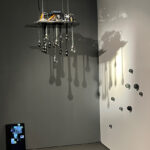Shona Kitchen, Ben Hooker: Cellular Noise-maker
Title:
Artist(s) and People Involved:
Exhibiting Artist(s):
Symposium:
Venue(s):
Artist Statement:
The roadside environment – where the tarmac stops and the grass embankment begins – is full of the detritus of city commuters, and rich in plant and animal life thriving in the nitrogenous air.
The cellular noise-maker is one of a noise farming devices that capture the ethereal turbulence of these roadside ecosystems, transmit these samples in data streams, or display them in light patterns. The Cellular Noisemaker explores not just how to live, but how to live well in urban environments which have an ever-increasing and complex electronic component.
Just as householders tend their gardens to improve the outlook, residents of Edge Town can adjust the position of electronic sensing machines (ie. Cellular Noise Maker) to better capture the ethereal turbulence of these roadside ecosystems. Physically austere, but with points of vulnerability (the sensors), these machines sample flows of roadside materials – the rate of dirt build-up, the shapes of pieces of dust, the rhythm of passing cars – and then transmit these samples in data streams, or display them in light patterns. In a well-tended ‘garden’ these transmissions are received by noise broadcasters, machines which re-transform these pieces of electronic data into images, sounds and shapes of different resolutions.
The cellular noise-maker is a portable steel box comprised of a central fluorescent display surrounded by a pattern of aluminium flexible flaps. It resembles a large portable radio, and can be carried around, keeping the house’s occupants company. As data is received by the device from other noise farming devices, it is stored in its memory and shown as an intricate pattern of dots on the central display (1). When its memory is full, the noise-maker uses its stored data patterns as a score to generate a sound burst of many simultaneous clicking noises by using electromagnets to rapidly move the flaps on its surface (2). The clicking noise ends in a sharp FM radio pulse (3) which is a highly compressed data burst of all its memory contents. Following this, the memory is wiped and the process starts again.







